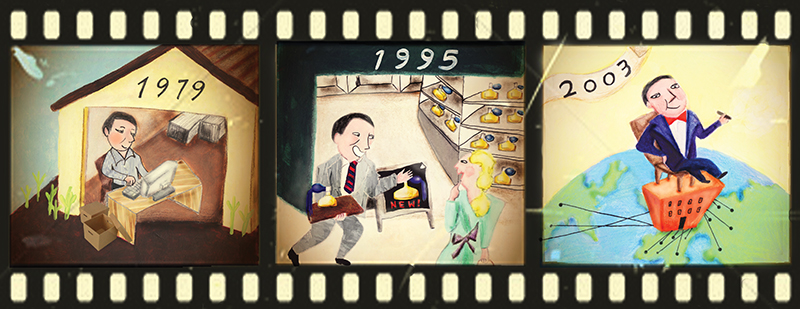By Neeru Paharia, Anat Keinan, and Jill Avery
In response to difficult economic and social realities, firms can successfully both inspire, and increase their appeal to consumers by strategically using underdog branding.
In recent years, underdog stories have captured the hearts and imagination of consumers around the world. Underdogs have been winning at the Oscars, on book store shelves, and in the polls. Underdog characters have been the champions in Oscar-winning movies such as Slumdog Millionaire, and blockbuster books such as J. K. Rowling’s Harry Potter, leading to billions of dollars in sales. In the 2008 U.S. presidential election both candidates, Barack Obama and John McCain, positioned themselves as underdogs to gain the support of voters. Politician Nick Clegg used the same strategy in 2010, claiming to be the British “Obama.” Underdog candidates have been the favorites of reality television show audiences such as Susan Boyle on Britain’s Got Talent, and the favorite teams in sporting events such as the 2010 World Cup and the 2008 Olympics.
Research in consumer behavior has only recently begun to look at how this “underdog effect” can be strategically applied to brands, but some brands, such as Virgin, have been using underdog narratives in their brand positioning for years. Virgin’s underdog brand biography begins with the personal biography of its charismatic founder, Richard Branson. Branson, who struggled with dyslexia and dropped out of school, started his business career with little going for him. However, Branson aimed high, claiming “My interest in life comes from setting myself huge, apparently unachievable challenges and trying to rise above them…from the perspective of wanting to live life to the full, I felt that I had to attempt it.” As he worked to build his branded empire, Branson took on some of the world’s largest brands, like British Airways and Coca-Cola, competing against them with much smaller marketing budgets and resources. His strategy became his brand, “What does the name Virgin mean? We are a company that likes to take on the giants. In too many businesses, these giants have had things their own way. We are going to have fun competing with them.” In Germany, Audi and Kia tout themselves as the “herausforderer,” the challenger who comes to the fight with less resources but more heart than the market leaders.
[ms-protect-content id=”9932″]Underdog stories about overcoming great odds through passion and determination are particularly resonant during difficult times as they inspire us and give us hope when the outlook we face is bleak. They promise that success is still possible, a much needed message in challenging social, political, and economic times. In the midst of the worst recession since the Great Depression, the economic challenges facing the world today have intensified due to the financial crisis of 2008, the collapse of the housing market, widespread job losses, rising health care costs, and crushing amounts of consumer debt. During recessionary time periods such as this, people feel increasingly disadvantaged, making them even more likely to identify with the struggles of underdogs. To reflect this reality, store shelves today are filled with stories of humble beginnings and noble struggles against overpowering adversaries, inspiring consumers to persevere during this cultural moment in history.
Underdog stories have commonly been popular during difficult economic times. The Great Depression spawned many of the great underdog stories in history. For example, in the U.S. circa 1937, Seabiscuit, the long-shot horse beat the likely winner, War Admiral, and became a symbol and inspiration for the little guy who came from behind and beat the odds. During this same time period, the Cinderella Man, James J. Braddock, was an impoverished ex-prizefighter who was seemingly as broken-down, beaten up, and out of luck as much of the rest of the American populace. He had hit rock bottom: his career appeared to be finished, he was unable to pay his bills, he was forced to go on public relief, and his family was in danger. Driven by love, honor, and an incredible dose of grit, Braddock never relinquished his determination and he willed an impossible dream to come true. In a last chance bid to help his family, he returned to the ring, where despite the odds, he kept winning. Carrying the hopes and dreams of the disenfranchised on his shoulders, Braddock rocketed through the ranks, until he took on the heavyweight champion of the world. His underdog appeal continues today as his story was more recently made into a blockbuster film.
Underdog stories are more appealing during difficult times because we tend to feel like underdogs ourselves when circumstances in our lives become difficult. Results of a consumer survey show that people today perceive themselves to be bigger underdogs compared to their peers, irrespective of their own demographic profile. Our studies also find that underdog stories can increase consumers’ self-efficacy and motivate them to pursue their goals and not give up. As the obstacles in our lives become greater, and our access to resources become fewer, underdog stories inspire us to look past our dark circumstances. These stories give us hope to overcome our own struggles because we identify with the failures and struggles of the underdog and we share their determination to succeed. When the underdog succeeds, we feel like we can succeed to meet the challenges in our own lives.
In response to difficult economic and social realities, firms can successfully both inspire, and increase their appeal to consumers by strategically using underdog branding. Several companies have been successful in these efforts. In 1964 Avis Rental Car was one of first to famously attempt an underdog brand strategy with the “we’re number 2, we try harder” campaign known to be one of the most successful advertising efforts in history. The recession of the early 1990s also generated some popular underdog brands. Clothing brand Volcom, is currently traded on NASDAQ, but the website still emphasizes the brands’ 1991 recession origin and its anti-establishment philosophy. Similarly, beverage brand Nantucket Nectars was purchased by Cadbury Schweppes in 2002, but still highlights its humble beginnings using precious packaging space to declare “We started Nantucket Nectars with only a blender and a dream.” Cliff Bar, a popular energy bar in the U.S., also uses the product packaging to tell the story of its founder, who in 1990 lived in his garage with his dog in order to have time to formulate the perfect energy bar in his mom’s kitchen.
Adidas footwear company’s recent “Impossible is Nothing” campaign emphasized the underdog stories of famous athletes, including Yelena Isinbayeva, Lionel Messi, and David Beckham. These underdog-oriented campaigns have not fallen upon deaf ears. Consumers’ favorite 2008 Superbowl advertisement was a Budweiser commercial with strong references to Rocky, a classic underdog. Personal brands can also make use of underdog biographies. Oprah Winfrey’s success is largely attributable to her ability to construct a repeating biographical narrative involving failure, struggle, and redemption.
Our research shows that building an underdog brand biography can have favorable outcomes for companies. We identify a significant “underdog effect” which can drive incremental sales for branded products and can sustain them as they grow. Across a series of five studies with over two-thousand consumers we test responses to underdog brand stories in a variety of contexts, measuring purchase intention and real choice.
To begin, we define the necessary components of an effective underdog brand biography as having two essential features: First, the underdog’s external environment is largely negative: Underdogs start from a disadvantaged position and encounters obstacles along the way, making it a more difficult struggle for them than for others. Secondly, the underdog’s internal characteristics are largely positive: Underdogs show perseverance in the face of adversity and are resilient even when they fail, staying passionately focused on their end goal. Both external disadvantage and internal passion are essential elements of a successful underdog biography.
We used these two components of this narrative to explore consumer attitudes towards a company that either had an underdog brand biography or a top dog brand biography. We found that consumers, particularly those who perceive themselves as struggling to win against the odds in their own lives, identified strongly with underdog brands leading to increased purchase intentions. To further investigate this proposition we tested whether affinity for the underdog would hold in a real choice setting for brands of chocolate. Consumers were given a choice between one brand of chocolate that had a top dog biography, and another brand that had an underdog biography. When considering these two brands together, consumers overwhelmingly selected the brand that was portrayed as having an underdog biography. This was especially true for one group of consumers, who, prior to choosing which chocolate they wanted, read reviews of movies that had strong underdog themes. Consumers were also more likely to choose the underdog brand of chocolate for themselves than for a friend. Taken together, these findings suggest that consumers root for underdogs because of underdog aspects in their own lives. When they feel more like underdogs themselves, they will be more likely to support underdog-branded products.
Underdog biographies may also be strategically applied to help companies avoid the “curse of success” when they get too big. Consumers have a complicated relationship with brand size and market success. On the one hand, many large, powerful, and dominant brands such as Disney, Coca-Cola, Starbucks, Toyota and Nike, enjoy widespread success and consumer loyalty. In an economic sense, size can be construed as a signal of a superior product. However, as brands grow and become more successful, they are often marked with the negative stigma that comes with being large and powerful. Work on schadenfreude, or taking pleasure in the misfortunes of others, shows that people enjoy seeing strong achievers fail (Smith et al. 1996; Brigham et al. 1997; Leach et al. 2003). This may translate into the enjoyment of seeing large corporations or brands fail. In recent years, some of the world’s largest and most popular brands have been targeted by activists. The most dramatic example of this anti-corporate sentiment was the so-called “Battle of Seattle,” which took place during a meeting of the World Trade Organization, when protests led to physical attacks on retail locations of transnational brands such as Starbucks. “Bigness” itself has come under attack in consumer culture, as movements explicitly favoring small, local businesses have thrived (Thompson and Coskuner-Balli 2007; Schor 2009). In our research we found that underdog biographies can be strategically applied to help companies avoid the “curse of success.” In one study consumers were asked to indicate their liking and purchase interest of three large companies, one with an underdog brand story, one with a top dog brand story, and one with no brand story. Consumers significantly preferred large companies positioned as emerging from underdog roots, than companies that had a top dog biography or no brand story.
Though underdog stories are appealing, they may be more compelling in cultures where underdog narratives are widespread. We hypothesized that Americans would be more receptive to underdog narratives than people from other cultures because of the unique role of underdogs in the history of the United States. The “American Dream,” an idea that many Americans hold close, is a myth built on the stories of underdogs who came to the United States with virtually nothing and pulled themselves up by their bootstraps to achieve success and gain material comforts. We explored the underdog effect from a cross-cultural perspective by having Americans and Singaporeans evaluate underdog brands. We found that people from both cultures preferred underdog brands to top dog brands but the effect was stronger for Americans. Based on the prevalence of underdog narratives in sports, culture, history, and religion in European countries, we expect that the underdog effects outlined above would similarly work.
How then can companies successfully build underdog narratives into their brands? First, underdog brand stories can be communicated via a variety of channels such as packaging, advertising, public relations, corporate websites, and other marketing communication vehicles. Second underdog biographies need to emphasize two necessary components: One is that of external disadvantage, specifically having more obstacles in your way and fewer resources to overcome them, and the second is that of passion and determination, the resilience, perseverance, and passion to pursue a dream even when obstacles are in your way. Third, underdog narratives are more compelling if they are built from a brand biography, a narrative authored to highlight historical events that have shaped a brand over time. An archetypal underdog brand biography is that of the passionate founder who starts her company in a garage. The garage itself is a symbol for disadvantage, and also of the hardship a founder is willing to endure in order to achieve her dream. Lindt chocolate uses a similar storytelling device when they stress the small pastry shop that spawned its brand. Other compelling underdog brand narratives might focus on taking a bank loan against one’s own home, or going forward with a business idea even when others warned against it. Fourth, companies should pay close attention to cultural context, and economics factors while constructing these appeals to more closely resonate with the prevailing sentiment of the populace.
Underdog branding stories can be used for big and small companies alike. It would be hard to realistically convince people that companies like Microsoft and Apple are underdogs in today’s marketplace. However, because there is a temporal component to the construct, they can always credibly refer to their underdog background as an origin story. In this specific example, Apple’s public relations machine has worked tirelessly to maintain the myth that the company started in a garage. Even though Apple is a market leader today, a constant referral to their humble beginnings gives them an appeal of authenticity that Microsoft does not enjoy. This narrative is credible today, as a large company, because they continue to take on new obstacles such as revolutionizing the music industry with iTunes, something others said could not be done. From the beginning consumers have felt inspired by Apple because they never give up even in the face of the impossible. Microsoft, on the other hand, has never emphasized its disadvantage or its passion and determination to overcome new obstacles, as either an origin story or as a current day narrative. Accordingly, though both companies are now relative titans compared to others in the tech world, Apple retains a significant brand advantage over Microsoft.
Similarly despite Virgin’s immense success, founder Richard Branson continued to spin underdog narratives, swooping in to become the “white knight” sponsor of the nearly bankrupt Brawn GP Formula One team in 2009 who then went on to win six of their first seven races. Once the Brawn team began winning and hired world champion driver and celebrity Michael Schumacher, Virgin decided to create its own racing team to regain its underdog street credibility. With the smallest budget in the sport, the Virgin team has inspired legions of fans to victory. Audi continues to call itself the “herausforderer” even after it began to outsell market leaders Mercedes-Benz and BMW.
Small brands continuing to struggle may also take advantage of underdog brand biographies. In our studies, consumers were not sensitive to whether the underdog was an eventual success, a failure, or had not reached the final outcome. In all cases, what consumers cared most about was that the underdog continued to persevere regardless of setbacks encountered along the way. Small brands facing acquisition by larger brands, in particular, may take advantage of underdog brand stories to maintain their authenticity. Rather than hide their association with their new large owners, small brands might even venture to position themselves against them as the new obstacle. Frito-Lay’s new brand of chips, Flat Earth Snacks, tells the story of a small group of passionate women within Frito-Lay who challenged the belief within the company that tasty snacks had to be unhealthy. In their branding, Flat Earth Snacks emphasizes the considerable opposition they faced from their parent company to bring these healthy snacks to market. Other brands whose authentic appeal has been threatened as they grow, can use underdog brand biographies to maintain brand value. Starbucks, in an effort to reverse declining sales, recently launched the Pike’s Place blend, which highlights the brand’s humble Seattle coffee culture beginnings.
Companies can strategically use underdog brand biographies to increase brand value, especially in difficult times. Consumers identify with underdog brands and are inspired by them to overcome the struggles in their own lives. Underdog brand biographies can be easily deployed, and strategically applied to companies as they struggle, or are most vulnerable to losing their authenticity as they grow or are being acquired.
About the Authors
Neeru Paharia is the research director at the Edmond J. Safra Foundation Center at Harvard University. Anat Keinan is an assistant professor of marketing at the Harvard Business School. Jill Avery is an assistant professor of marketing at the Simmons School of Management.
[/ms-protect-content]



























